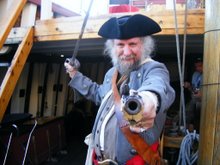Yesterday the Santa Maria celebrated the 518th anniversary of Columbus leaving port (the actual date is tomorrow but special events work better on weekends). Since the event is called "Navigation Day" I brought some of my personal collection of navigational tools and gave some talks on period navigation. At the same time, I've been reading Flint and Silver. A major plot point of this (and of Treasure Island) is that Long John Silver and his crew of pirates do not know how to navigate. This was also a plot point in Captain Blood. This got me thinking about period navigation. What was it that made navigation so difficult?
Any time a ship was out of sight of land it used "dead reckoning." This boils down to keeping careful track of what direction you are going and how fast you are traveling and figuring your position from that. The basic tools were the compass, the sandglass, the traverse board, and the log line (with its own sand glass).
Every half hour the helmsman would turn the glass and put a pin in the traverse board. The traverse board looked like the face of a compass and had eight concentric rings of holes. Each ring corresponded to a turn of the glass and each hole corresponded to a point on the compass. There were 32 points.
At the same time, the ship's speed would be taken with a log line. This was a spool of cord with a piece of wood on one end. The piece of wood would be thrown overboard and it would pull the cord out after it. The cord had knots at regular intervals. A sand glass would be turned. When the sand ran out you would see how many knots had unspooled and mark that on a scale at the bottom of the traverse board.
At the end of a shift, the results would be written on a slate and given to the navigator. He would use this to plot how far the ship had come and which direction and mark it on his charts.
This is where things get complicated. Each chart might have its own scale. Trying to match positions from one chart to another could be difficult.
Any changes in course would affect the accuracy. If the course was changed five minutes into a shift it would still show the same as if it had been changed 25 minutes into the shift.
The effects of currents had to guessed. The only way of measuring a current was to drop a sounding lead into the water and see if the line bowed out some.
The majority of people at that time could add and subtract but not multiply or divide. Some multiplication and division was needed.
There were other tricks that came from instruction or practice. If the bottom was close enough for a sounding, you would put some fresh tallow into a depression in bottom of the sounding lead. This would bring up a little of the bottom. Really detained charts of known waters might include information about the bottom - sandy, gravel, silt, etc. Even if you were out of sight of land, silt meant that a river mouth was near.
You could check your latitude with various instruments that measured the angle of the sun or North Star. There was no way of figuring longitude at sea.
Sailors left all of this to the navigator. Without charts and the logs, there was no way for them to tell anything but the rough direction, anyway. All that mattered to them was not getting lost.
Subscribe to:
Post Comments (Atom)


No comments:
Post a Comment